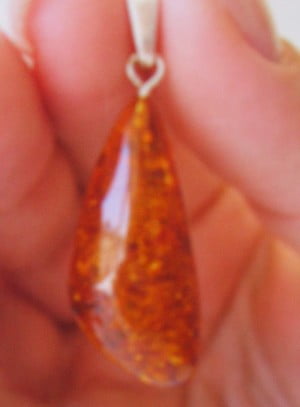I have been fascinated with amber as long as I can remember. The first piece I saw was in a museum store and it had a bug in it. I was only 10, so I begged my grandpa to buy it for me. He bought it and that got me started collecting rocks and minerals, which I still do to this day. But what is amber?
Amber is the fossilized, hardened resin of a pine tree. It formed approximately 50 million years ago. Amber is found mostly in the Baltic region, but deposits have been found in Italy, Romania, China, Japan, Canada, Mexico and the United States (Alaska and New Jersey). It is usually a drop or nodular shape, though pieces weighing 22 pounds or more have been found. Amber is sometimes referred to as Succinite, Simetite and Rumanite and can be confused with other gemstones such as citrine, flourite, meerschaum and yellow glass. The chemical composition of amber is carbon (10) hydrogen (16) and oxygen with a mixture of various resins. Amber has a refractive index of 1.539 to 1.545 and a fluorescence that is bluish-white to yellow-green. It often looks transparent or opaque because of fine lines, numerous bubbles or tension fractures. The color can range from yellow to orange to brown and there are occasional inclusions of insects or parts of plants. Amber is sensitive to acid, gasoline, alcohol and perfume. It has a Mohn’s hardness rating of 2 and can be ignited by a match, smelling like incense. If you rub amber with a cloth it becomes electrically charged and can attract small particles.
The largest deposit of amber can be found just west of Kaliningrad, Russia. It is under approximately 100 feet of sand and within a layer of clay. It is removed from the earth with dredging chain buckets, washed out and finally picked over by hand. Only 15% of amber found is suitable for jewelry. The remainder is used for technical purposes or made into amboid, which is a type of pressed amber.
There are large reserves of amber on the seabed of the Baltic. After heavy storms it is found on the beaches and in the shallow waters along Russia and other bordering countries. The sea amber is especially solid and regularly fished for by fishermen.
Amber has been used since prehistoric times for religious objects, amulets, jewelry, and as accessories for smokers. Baltic amber, commonly called the “gold of the north” is one of the earliest used gem materials. It boggles the mind to think that the inclusions found in some of the amber pieces are 50 million years old and can possibly hold the DNA of plants and dinosaurs that roamed the earth back then. Museums are full of historical objects that most of us could never afford to buy, but amber is something you can touch, hold and own for a very small price. Today, it can be found in pendants, brooches, bracelets, necklaces, rings and ornamental objects.
Amber has been ascribed to have many healing properties, and it was used for that purpose for many centuries. It is believed to absorb negative energy, calm nerves and give confidence, as well as lessen depression and anxiety.
Buying a piece of amber, set in sterling silver or gold is a great way to start a unique gem collection. There’s no other gemstone sold that has the unique history or chemical composition of amber.





